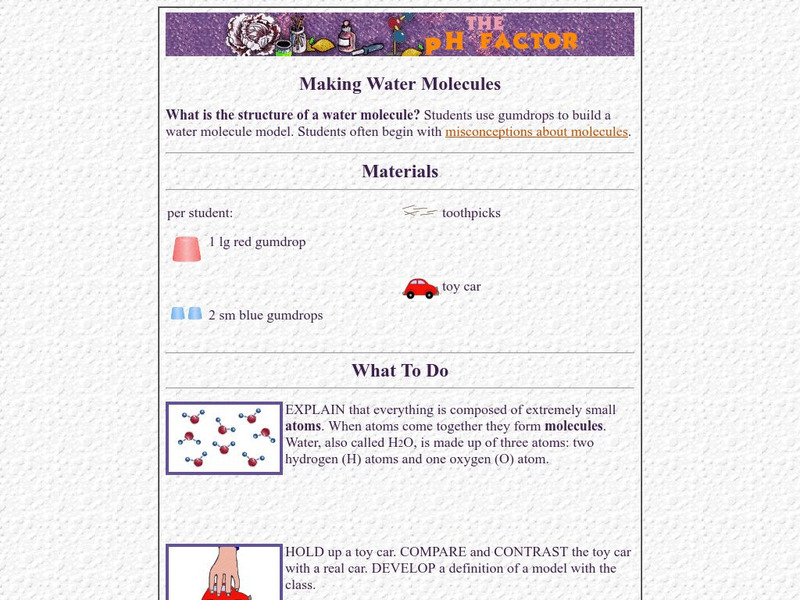Hi, what do you want to do?
Curated OER
Let the Sunshine in
High schoolers collect and analyze data to study wavelengths of visible light. They cover Styrofoam cups with three different colors of sun filtering products and shine a lamp directly on the cups. They determine the most effective...
Curated OER
Genome: The Secret of How Life Works
Young scholars explain how DNA directs the production of proteins.
Curated OER
Necessary Nitrogen
Students view a video that presents the biogeochemical cycle of nitrogen. They compare types of soils and consider how different fertilizers affect soil composition.
Curated OER
World Wide Winds
High schoolers recognize that global winds move in specific directions in specific latitudes and describe that in a written form. They relate the motion of the wind belts to historical navigation.
Curated OER
What's the Big Deal?
Learners define terms and describe where they are found and formed. In this methane lesson students complete an activity and describe ways in which methane hydrates impact our lives.
Curated OER
The Nitrogen Cycle
Fifth graders investigate the nitrogen cycle and examine the concepts of decomposition and nitrification. Students participate in a class discussion about the creation of waste and ammonia compounds, then using nitrogen cycle cut-outs...
Curated OER
What's In Crude Oil?
Students investigate crude oil. In this crude oil lesson, students investigate fractional distillation and use this technique to separate two liquids.
Curated OER
Does the Chicken have Anthrax (Explain I)
Students explain how each of the components of innate immunity function in the protection of the body. Following an investigation, they articulate how innate immunity functions.
Curated OER
Ions in the Environment
Learners explain the importance of the five main biogeochemical cycles. In this chemistry lesson, students discuss how ions are transported in the environment. They design an experiment to collect data on eutrophication.
Curated OER
Is There Really Life on Mars?
Learners examine the work of scientists and determine how they test their theories.
Curated OER
Extraction of DNA from White Onion
High schoolers conduct lab test with minced onion to determine where chromosonal DNA is located within the cell, and whether or not it can be extracted.
Curated OER
Jell-O Optics
Students observe an activity with Jell-O to learn about optics. In this investigative lesson students fill out a handout on the activity that helps them to investigate the index of refraction and the speed of light.
American Chemical Society
Middle School Chemistry: Lesson Plans: Water Is a Polar Molecule
Students develop their own water molecule model to help them understand the idea that water has a slight positive charge at one end of the molecule and a slight negative charge at the other.
Concord Consortium
Concord Consortium: Molecular Workbench: Water Molecules & Carbon Nanotubes
View this simulation to observe how water molecules move through carbon nanotubes.
Museum of Science
Miami Museum of Science: Making Water Molecules
This simple lesson involves making a model of a water molecule from gumdrops. A toy car is also used to explain how a model compares to the real thing.
University Corporation for Atmospheric Research
Ucar: Just a Phase: Water as a Solid, Liquid, and Gas
This site helps students construct a model of the arrangement of water molecules when present as solid, liquid or gas. Includes background information, lesson plans, links to standards and assessment ideas.
Concord Consortium
Concord Consortium: What Happens to the Energy of Water Molecules During Hurricanes?
In this investigation students will add energy to the model of how molecules interact by completing the following activities. Activity 1 What does boiling do to water molecules? Activity 2 How hot can water go? Activity 3 How does energy...
American Chemical Society
Middle School Chemistry: Lesson Plans: Why Does Water Dissolve Salt?
Students use their own model of a salt crystal and water molecule to show how water dissolves salt. Then, they relate their observations to the structure of salt, water, and alcohol on the molecular level.
Concord Consortium
Concord Consortium: Molecular Workbench: Water and Polar Substances
Adjust amounts of ionic charges in this simulation to see how water molecules react to polar substances in solution.
American Chemical Society
Middle School Chemistry: Changing State: Evaporation
Students build a model of a water molecule and design an experiment to see if adding energy affects the rate of evaporation.
Other
Chemical Education Digital Library: Carbonic Acid H2 Co3
A 360 degrees view virtual model of a carbonic acid molecule. Students can manipulate the model to explore its properties.
Other
Beautiful Chemistry: Molecular Structures
These models show the structures of some basic molecules such as water and carbon dioxide, then move on to show more complex molecular strautures.
Concord Consortium
The Concord Consortium: Molecular Workbench Micelle Formation
Watch how micelle formation changes in a solution with water compared to a solution consisting of oil.
Utah STEM Foundation
Utah Stem Action Center: Salt Dissolved in Great Salt Lake
In this lesson, learners will compare water from a fresh lake to water from the Great Salt Lake to begin to build a conceptual model for how salt dissolves in water. The lesson focuses on students using and developing models of molecules...























